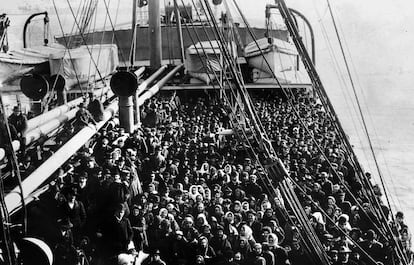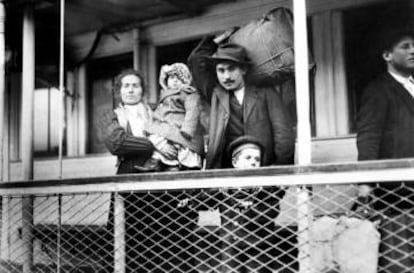Immigrant America: From the Great Inclusion to the Great Expulsion?
The US has an extraordinary ability to absorb immigrants but there have always been roadblocks

Surprisingly, to judge from the headlines, in a world of more than seven billion people only 3% are international migrants, living outside the countries where they were born. Still, the world is increasingly on the move, especially from the global south to the global north, being ineluctably transformed in the process. We live in a world with a declining proportion of rich (and older) people and a growing proportion of poor (and young) people; in which migration pressures will continue to mount as a result of global inequalities and intractable conflicts; and in which the more developed countries are at a crucial demographic and labor force crossroads.
Immigration is a transformative force, producing profound and unanticipated social changes in both sending and receiving societies, in inter-group relations within receiving societies, and among the immigrants themselves and their descendants. Immigration is followed predictably not only by acculturative processes on the part of the immigrants, but also by state policies that seek to control the flows and by different forms of reaction on the part of established residents and politicians, who may view the alien newcomers as cultural or economic threats. The fear of the foreigner – the xenophobia of what has been called a “society of contempt” – has been variously rising in tandem with all forms of international migrations, exacerbated by a global economic crisis, terrorist attacks, war, and refugee flows.
Obama has presided over the largest number of deportations in American history
An iconic feature of the American experience has been the remarkable capacity of that self-professed “Nation of Immigrants” to absorb, like a giant global sponge, tens of millions of newcomers from all classes, cultures and countries. This phenomenal accomplishment, however, has historically coexisted with a seamier side of the process of nation building and design. Indeed, much of American history can be seen as a dialectic of processes of inclusion and exclusion, and in extreme cases of expulsions and forced removals.
The magnitude of processes of inclusion might be conveyed by a tale of two cities. Take New York, the quintessential American immigrant city. From 1820 (when records on arrivals began to be kept) to 1892 (the year that Ellis Island opened at the entrance to New York harbor, adjacent to the Statue of Liberty, which had been installed on its pedestal in 1886), immigrants arrived by ship first at docks on the tip of Manhattan, and then through nearby Castle Garden (the nation's first immigrant processing facility). More than 100 million Americans can trace their (overwhelmingly European) ancestors to this early immigrant period. Then from 1892 until it closed in 1954, Ellis Island became the gateway for over 12 million immigrants as the country's busiest immigrant inspection station, with the lion's share coming in the decade between 1905 and 1914; after 1924 Ellis Island became primarily a detention and deportation facility. Another 100 million Americans are descended from those immigrants who first arrived at Ellis Island before dispersing to points all over the country. Thus, stunningly, over half of the US population of 320 million today can trace their origins to newcomers who entered through New York City in the century between the 1820s and 1920s.

On the west coast, the story developed quite differently – especially in Los Angeles, which has emerged as the premier immigrant metropolis in the world today. It is difficult to overstate the demographic transformation of California that has ensued over the past half century. As late as 1960 Los Angeles was the whitest, most Protestant major city in the country. By the end of the 1980s, however, fully a third of all immigrants to the US had settled in California; and today, of the 10 million people in Los Angeles County (the nation's largest county), 72% are ethnic minorities (that is, 7.2 million people, significantly larger than the populations of most states of the US). Indeed, southern California is home to the largest concentrations of Mexicans, Salvadorans, Guatemalans, Filipinos, Koreans, Japanese, Taiwanese, Vietnamese, Cambodians, Iranians, and other nationalities found outside of their respective countries of origin—and to sizable contingents of others, such as Armenians, mainland Chinese, Hondurans, Indians, Laotians, Russian and Israeli Jews, and several Arab nationalities. Most of the largest immigrant nationalities that have settled in the United States since the 1960s have established their primary settlements in greater Los Angeles.
Today, immigrants still account for over a quarter of California’s population of 38 million people, and over a quarter of all of the nation’s immigrants reside in California. They benefited from the 1965 Immigration Act (which repealed the racist 1924 National Origins Quota Act), the resettlement of hundreds of thousands of Cold War refugees from Cuba and from Vietnam, Laos and Cambodia after the end of the Indochina War in 1975, and the amnesty provisions of the Immigration Reform and Control Act (IRCA) to undocumented immigrants in 1986. The 1970 population census counted the lowest proportion of foreign-born people in US history: 4.7%. Today, that share is over 13% nationally, nearing the historic high of 14.8% set in the late 1890s and early 1900s.
An iconic feature of the US has been its remarkable capacity to absorb newcomers from all classes, cultures and countries
The ethnic and national diversity of contemporary immigrants in the US pales in comparison to the diversity of their social class origins. By far the most educated and the least educated groups in the United States today are immigrants, a reflection of polar-opposite types of migrations embedded in different historical contexts – and inserted in an “hourglass-shaped” labor market, increasingly bifurcated into high-tech/high-wage and manual/low-wage sectors, which attracts both immigrant professionals and undocumented laborers.
The latter have, over the past two decades in particular, emerged at the most contentious element in the politics of immigration. Of the approximately 43 million immigrants in the US today, just over a fourth– an estimated 11 million – are undocumented. Several million of them came as children; a segment of these, the so-called "Dreamers," have been the beneficiaries of "deferred action" policies by President Obama aiming to incorporate them by providing them with temporary legal status, access to the legal labor market and driver's licenses, and security from deportation.
The United States today – with the improbable rise to power of a demagogue who began his campaign for the presidency by falsely attacking Mexican immigrants as criminals and rapists, proposing the construction of a wall along its southern border, the ending of birthright citizenship (a hallmark of US constitutional law since the end of the Civil War), the establishment of a Muslim registry, the reduction of refugee resettlement (or denial of refuge to entire nationalities), federal defunding of "sanctuary cities," and vast increases in immigrant detention and deportations from already record highs – is about to embark on an uncertain era: potentially one of the most tragic and shameful in the history of “Immigrant America.”
Only 3% of the world’s seven billion people live outside the country where they were born
The current moment harks back to the Know Nothings of the mid-19th century and their virulent anti-Catholicism; the later nativist movements against Southern and Eastern Europeans, culminating in the restrictionist and racist National Origins Quota Act of 1924; the anti-German hysteria of World War I; and exclusions ranging from the forced removal of indigenous populations, to the Chinese Expulsion Act of 1882 (the year before Emma Lazarus penned her poem welcoming the huddled masses yearning to breathe free), the Asiatic Barred Zone of 1917, the internment of Japanese Americans during World War II, and the "repatriation" (forced removals) during the 1930s of a million Mexican Americans (over half of whom were US citizens), representing an estimated one third of the total Mexican American population in the US at the time.
Today’s "Deportation Nation" has been forged by the militarization of the border; the passage of draconian federal laws in 1996 that greatly expanded the categories of deportable offenses; a formidable and well-funded machinery for immigrant detention and deportation; the shutdown of any meaningful federal reform legislation, including the "DREAM Act;" and the proliferation of hundreds of state and local laws and ordinances seeking to control immigration at the local level despite constitutional mandates to the contrary. Ironically, President Obama, who entered office on campaign promises of immigration reform, will leave office having presided over the largest number of deportations in American history. History may not repeat itself, but it echoes.
Ruben G. Rumbaut is an expert on US immigration and Distinguished Professor of Sociology at the University of California.
Tu suscripción se está usando en otro dispositivo
¿Quieres añadir otro usuario a tu suscripción?
Si continúas leyendo en este dispositivo, no se podrá leer en el otro.
FlechaTu suscripción se está usando en otro dispositivo y solo puedes acceder a EL PAÍS desde un dispositivo a la vez.
Si quieres compartir tu cuenta, cambia tu suscripción a la modalidad Premium, así podrás añadir otro usuario. Cada uno accederá con su propia cuenta de email, lo que os permitirá personalizar vuestra experiencia en EL PAÍS.
¿Tienes una suscripción de empresa? Accede aquí para contratar más cuentas.
En el caso de no saber quién está usando tu cuenta, te recomendamos cambiar tu contraseña aquí.
Si decides continuar compartiendo tu cuenta, este mensaje se mostrará en tu dispositivo y en el de la otra persona que está usando tu cuenta de forma indefinida, afectando a tu experiencia de lectura. Puedes consultar aquí los términos y condiciones de la suscripción digital.
More information
Archived In
Últimas noticias
From Andorra to Gibraltar, a black market for Ozempic exploits its success: ‘They’re the most sought-after products in the world’
From Hungary’s Orbán to Chile’s Kast: How Trump helps turbo charge the far right
Magnets in their heads: How some animals guide themselves using the Earth’s magnetic field
The brief rise and retreat of Generation Z in Mexico
Most viewed
- Why we lost the habit of sleeping in two segments and how that changed our sense of time
- Trump’s obsession with putting his name on everything is unprecedented in the United States
- Charles Dubouloz, mountaineering star, retires at 36 with a farewell tour inspired by Walter Bonatti
- Venezuela faces its most tense Christmas yet
- The Florida Keys tourist paradise is besieged by immigration agents: ‘We’ve never seen anything like this’











































